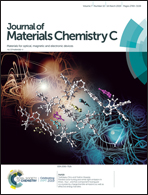A novel molecular design employing a backbone freezing linker for improved efficiency, sharpened emission and long lifetime in thermally activated delayed fluorescence emitters†
Abstract
A novel molecular design employing a backbone structure freezing linker was developed to improve the external quantum efficiency, lifetime and emission profile of thermally activated delayed fluorescence (TADF) emitters. The backbone structure freezing linker was introduced in the TADF emitters having diphenyltriazine as an acceptor and bicarbazole, triscarbazole, and indolocarbazole as donors. A dibenzofuran moiety was the backbone structure freezing unit between the donor and acceptor units, which are positioned at the 3 and 4 positions of dibenzofuran. The dibenzofuran linker worked as a rigid freezing unit compared with the common phenyl linker, which yielded an improved efficiency, sharpened emission spectrum and extended lifetime. The dibenzofuran mediated TADF emitter exhibited a high external quantum efficiency of 23.5% and lifetimes surpassing those of the state of the art green TADF emitters. This is the first work simultaneously reporting both a high efficiency over 20% and lifetime longer than other state of the art TADF emitters.

- This article is part of the themed collection: 10th Anniversary: Dedicated Authors


 Please wait while we load your content...
Please wait while we load your content...